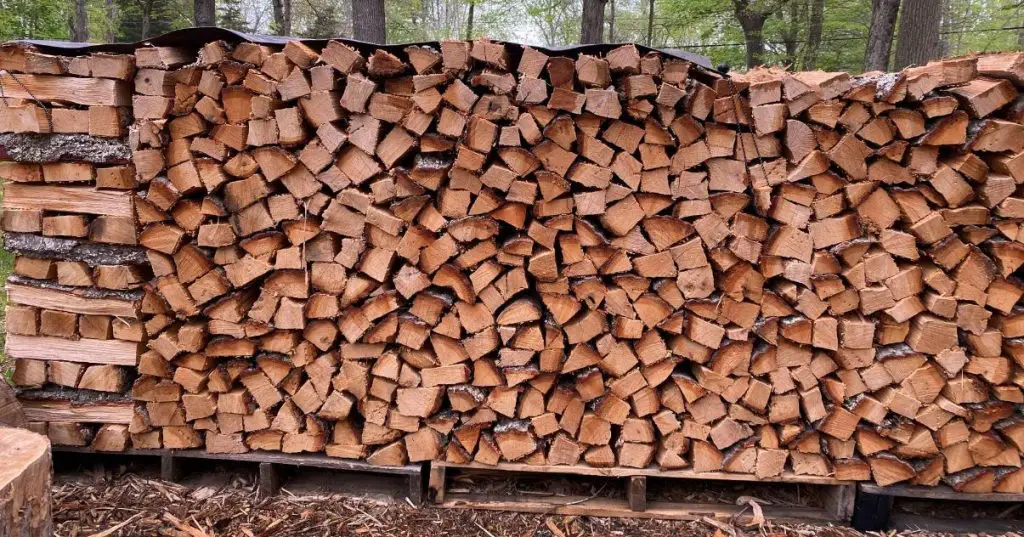Red oak is the best and most popular firewood in North America. It has a high heat production, doesn’t smoke or spit, is relatively easy to split, and is widely available.
Red Oak is split into two sub-species – Northern or Southern Red Oak, each with its own characteristics. In this article, I have put together everything you need to know about using red oak as your primary fuel source this winter.
Table of Contents
Summary
- BTU: 24.6 million BTU/cord
- Weight: 4888 lb/cord green
- Seasoning Time: 12-24 months
- Splitting Difficulty: Moderate
- Sap Content: Low
- Smoke: Low
- Smell: Sweet
Overall, red oak is one of North America’s premium hardwood firewood options. It is widely available, has a high heat production, doesn’t generate much smoke or creosote, and has a pleasant smell. It is one of my go-to firewood as my winter’s primary fuel source. The yield of firewood per tree is high, and you don’t need to buy as many cords to heat your home all season.
However, it does take 1 to 2 years to season thoroughly, so make sure you have planned well in advance. It also is more difficult to split than white oak because of its knots in the grain. The trees are huge, so you may need to hire a log splitter to process the entire load.

Heat Production
Red oak is one of the best firewood for heat production at 24.6 million BTU/cord. This is right up there with the premium hardwood firewood. It means that you don’t need to store as many cords for winter, and you don’t need to add logs to your fireplace as frequently.
The wood burns hot and produces coals that are excellent for cooking. They hold their temperature well, allowing you to restart the fire more easily in the morning or providing a stable temperature profile for grilling meat.
The high burning temperature also means less creosote soot is formed in your chimney.
Red oak does have a slightly lower heat production than white oak at 26.4 million BTU/cord, but I don’t think this is a large enough difference that you will even notice.
Smoke Production
Red oak doesn’t produce a lot of smoke compared to woods with high sap contents, such as pine. If you season your firewood correctly, then it is one of the lowest-producing smokes. The smell is pleasant, and I use it as my baseline for comparison of all other wood smells.
The only risk of generating more smoke is burning unseasoned oak firewood, which I recommend avoiding at all costs. If you think you are running out of time and may need to burn green oak firewood, you can buy some other species that season more quickly to get you through a rough patch.
Seasoning Time
Red oak takes a long time to season, typically between 1 and 2 years. This is a very dense wood that simply takes a long time for the moisture to seep out through the fibers and to be removed. There are ways to try and increase the drying rate, such as chopping your wood into smaller pieces, stacking them in high airflow stacks, covering the top from rain, and leaving the sides open to sunlight.
I always recommend never burning green wood because you will lose a significant amount of heat efficiency, increase the smoke generation, increase the potential for foul smells, and increase the amount of creosote buildup.
I personally recommend this General Tools Moisture Meter. It allows you to accurately gauge how wet your firewood is and whether it is sufficiently seasoned. Over time you can also see how quickly the moisture is dropping and how much longer you need to keep your firewood dropping until it is seasoned and ready to burn.
Press the sharp pins into the wood and you will quickly see the readout show the moisture ranging from 5% to 50%. It also has a Low/Mid/High indication depending on whether the wood is dry enough, so you don’t need to remember the actual values.

Burning Smell
Oak does have a distinct burning smell. It isn’t particularly strong or pungent, but I would describe it as sweet and pleasant. Oak is one of the most widely burnt woods for heating homes, so I have long ago associated the smell of oak with the normal smell of smoke. I consider oak smoke to be the baseline for every other wood to be compared against.
The pleasant smell means that red oak is ideal for burning indoors. It doesn’t produce a lot of smoke so if you don’t have great ventilation, it is a better option.
If you are especially interested in odor for smoking meats or if you are sensitive to smell, have a read through this guide I have written about the best smelling firewoods to burn.
Creosote Buildup
Creosote builds up in your chimney due to unburnt wood – this is more common in colder burning softwoods with a high resin content. It forms a black soot that can combust and cause chimney fires over time. It is essential that you clean your chimney regularly regardless of the type of wood you are burning.
Red oak doesn’t form a lot of creosote because it burns so hot. It is ideal for burning indoors to heat your home. I still recommend cleaning your chimney annually, but you are in a much safer position if burning hardwoods. Pine is one of the worst offenders for creosote formation.
Splitting
I find red oak more difficult to split than white oak. It does tend to have knots in the trunk, especially where the larger, lower branches grow from. Depending on the size of the tree, you may consider using a hydraulic log splitter to process the rounds into logs. You get a high firewood yield from a large oak tree and may not want to spend the next few days with a heavy splitting maul.
Because of the length of time it takes to dry red oak firewood, I recommend splitting it into smaller-sized pieces as early as possible to give additional time with the logs in high airflow stacks.
If you are going to split red oak with a splitting axe, you should consider getting a splitting block, so the force you apply isn’t dispersed into the ground. This is an easy way to improve your splitting efficiency and reduce muscle fatigue over time.
Different Types/Species
Red oak isn’t an individual species but a group of trees. There are plenty of different subspecies within this group, including Pin Oak, Black Oak, Scarlet Oak, and Shumard Oak. I have given more details of the most common species: the Southern and Northern Red Oaks.
Southern Red Oak
Also known as the Spanish oak or Quercus falcata, the Southern Red oak is found from southern New York to Texas and Florida. It has thinner bark than other species, often damaged from wild weather or fires. It is a vital provider of hardwood to the southern US states. They can grow to over 140 feet tall with a trunk of over 5 feet in diameter.
Northern Red Oak
Also known as Champion oak or Quercus rubra, it is found throughout the Eastern United States and Canada. It has a distinctive grain pattern in its bark. It grows straight and tall up to 140 feet with a trunk of over 6 feet in diameter. They can grow for over 400 years.
Comparison to Other Woods
Here, I’ve taken some of the most popular firewoods to burn indoors and compared them to red oak firewood.
Red oak is one of the premium hardwood firewood, and from the table below, it is easy to see why. It has one of the highest heat productions and produces excellent cooking coals without generating a lot of smoke. In my opinion, it is one of the best wood species, and because of its wide availability, I have given it a rating of excellent.
| Firewood | Million BTU/Cord (source) | Ease of Splitting | Coals | Overall Quality |
| Green Ash | 20 | Easy | Good | Excellent |
| Maple | 25 | Easy | Excellent | Excellent |
| Bur Oak | 26 | Easy | Good | Excellent |
| Red Oak | 25 | Moderate | Excellent | Excellent |
The clear comparison is between red oak and bur oak. Bur oak has a slightly higher heat production and is easier to split. I have also put together the following comparison between red oak and white oak.
White Oak versus Red Oak Firewood
Red oak is the second most popular oak species to use as firewood. White oak is superior in many ways, but both are incredible firewood choices.
White oak burns cleaner, hotter, and longer. White oak is also non-porous, which means it will not seep up water, which red oak will. White oak produces less smoke and has a better smell.
However, with all that said, red oak is still premium firewood performing wonderfully. Red oak also splits much more effortlessly than white oak, making it a favorite for some.
Red oak is also more readily available in some areas of the United States and is, therefore, cheaper and more sustainable to use in those regions.
FAQs
Can you burn red oak wood in a fire pit?
Red oak is ideal for burning outdoors while camping in your fire pit. It burns hot and produces excellent coals for cooking that provide a stable temperature profile. Red oak is one of the best hardwood fuel sources and is widely available. I am always happy if I find a source of seasoned red oak near my campsite.
Can you burn red oak wood in a wood stove?
Red oak is ideal for burning indoors to heat your home in winter. It doesn’t produce much smoke and has a slight, pleasant smell. The high heat production means you don’t need to add logs to the fireplace too frequently and it doesn’t form much creosote in your chimney. Red oak is one of the best firewood for burning indoors.
How much does red oak firewood cost to buy?
Red oak costs around $300-$500 per cord, depending on your location and the time of year. It is widely available, and you shouldn’t have much difficulty in finding enough cords to stockpile for winter. You can also find red oak firewood available in bundles for around $7 each for camping from local hardware stores.
Final Thoughts
Red oak is one of North America’s premium hardwood firewood options. It has an extremely high heat production, doesn’t generate much smoke, doesn’t produce a lot of creosote, is widely available, and is easy to split and process. I use oak extensively as much primary fuel source for winter – its one downside is that it takes multiple seasons to dry so make sure you plan early and set up your stack for maximum airflow.
